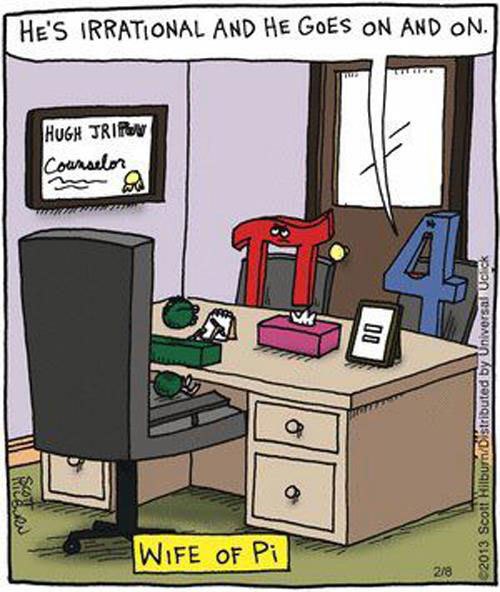Happy Pi Day!
By Laura Seeholzer

It’s a fact
A ratio immutable
Of circle round and width
Produces geometry’s deepest conundrum
For as the numerals stay random
No repeat lets out its presence
Yet it forever stretches forth
Nothing to eternity.
– David Saul and Danielle Mathieson
Can you figure out the pattern in this piem (pi + poem – us math geeks love wordplay)? Remember, pi = 3.1415926535897932384626433832795028… It is not a coincidence that the first word word of the poem has 3 letters, the second word has 1 letter, the third has 4 letters, etc. People use piems as mnemonics (piphilology) to memorize the digits of pi. However, if you want to memorize large sequences of pi, I would recommend more creative methods.
Currently, Lu Chao holds the world record for number of digits recited. Over the course of 24 hours and 4 minutes he recited 67,890 digits of pi. There were no bathroom breaks because the Guinness Book of World Records mandates that you only have 15 seconds between numbers. The youngest pi competitor, so far, is a three-year-old girl, Grace Hare, who recited 31 digits! What a feat. I’m excited when I correctly recite my nine digit social security number.
Pi is the ratio of a circle’s circumference to its diameter. As school children, pi is the first irrational number we learn, and as adults it is typically the only irrational number we remember. The number hold such a prominent place in our hearts because circles dominate both natural and man made worlds.
Circles were pervasive in the architecture, art and tools of early civilizations. As early as 2000 BC, the Babylonians and Egyptians recognized that the circumference and diameter have a constant ratio. A mixture of fascination and necessity drove them to approximate that ratio.
Babylonians: pi = 3 1/8 ≈ 3.125 (only 0.53 % off!)
Egyptians: pi = 4*(8/9)2 ≈ 3.1605 (only 0.60 % off!)
These were pretty incredible approximations considering that at this time, wooly mammoths were still alive, and materials like glass, iron, and bronze were still unknown to humans. Interestingly, the concept of pi and the concept of zero was conceived of around the same time, though zero took much longer to catch on.
Now, thanks to the work of some dedicated mathematicians, pi has been calculated up to 10 trillion digits. Think of how many years it would take Lu Chao to recite that.
So today, March 14th, let’s all raise our forks and dig into this delicious number, preferably at 1:59! (3.14159 = 3/14 at 1:59)
